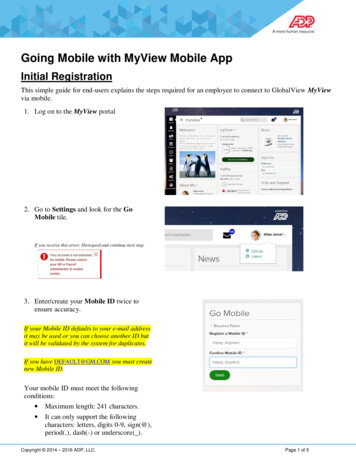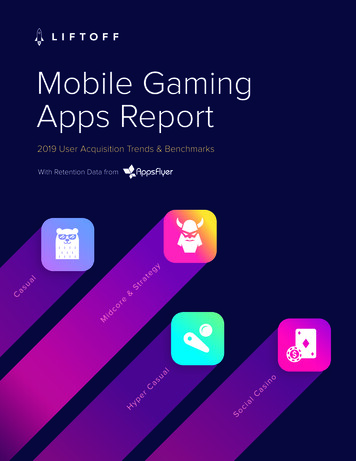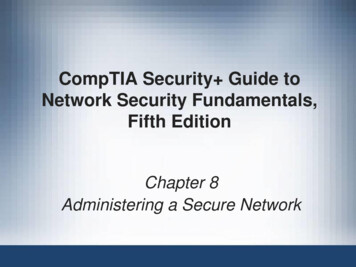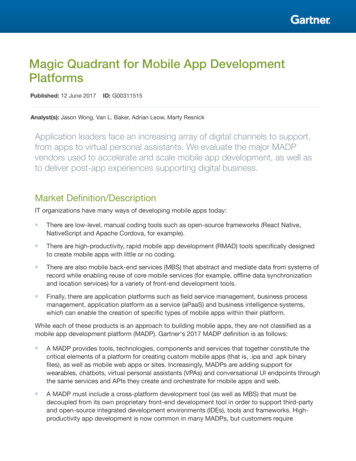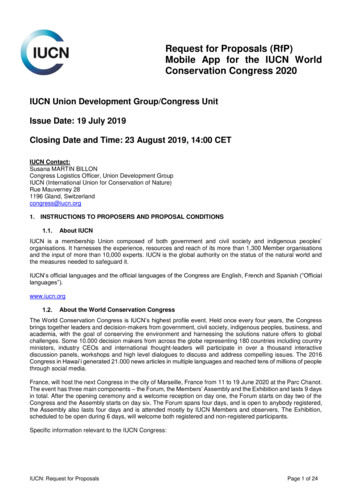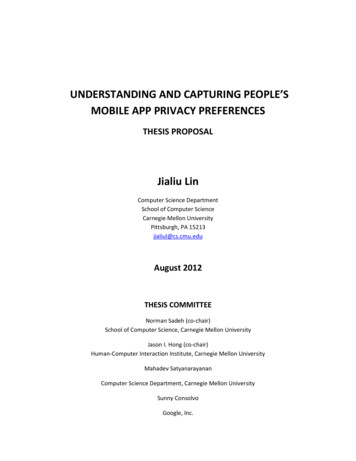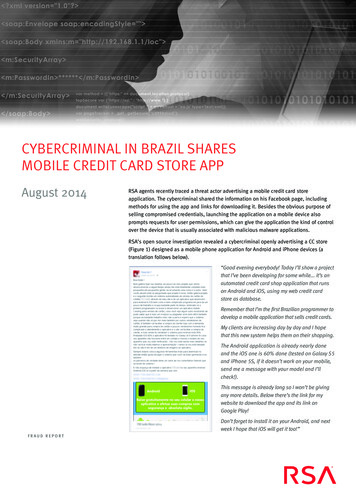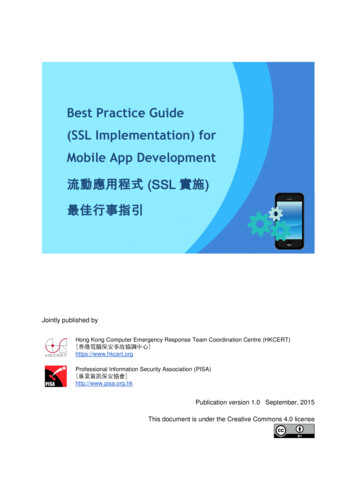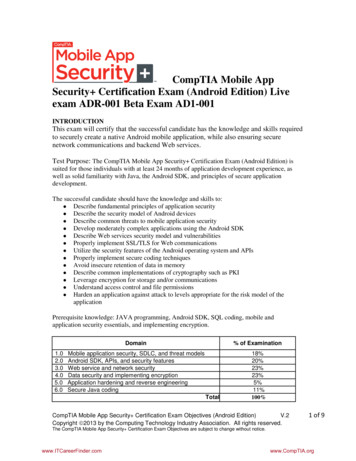
Transcription
CompTIA Mobile AppSecurity Certification Exam (Android Edition) Liveexam ADR-001 Beta Exam AD1-001INTRODUCTIONThis exam will certify that the successful candidate has the knowledge and skills requiredto securely create a native Android mobile application, while also ensuring securenetwork communications and backend Web services.Test Purpose: The CompTIA Mobile App Security Certification Exam (Android Edition) issuited for those individuals with at least 24 months of application development experience, aswell as solid familiarity with Java, the Android SDK, and principles of secure applicationdevelopment.The successful candidate should have the knowledge and skills to: Describe fundamental principles of application security Describe the security model of Android devices Describe common threats to mobile application security Develop moderately complex applications using the Android SDK Describe Web services security model and vulnerabilities Properly implement SSL/TLS for Web communications Utilize the security features of the Android operating system and APIs Properly implement secure coding techniques Avoid insecure retention of data in memory Describe common implementations of cryptography such as PKI Leverage encryption for storage and/or communications Understand access control and file permissions Harden an application against attack to levels appropriate for the risk model of theapplicationPrerequisite knowledge: JAVA programming, Android SDK, SQL coding, mobile andapplication security essentials, and implementing encryption.1.02.03.04.05.06.0Domain% of ExaminationMobile application security, SDLC, and threat modelsAndroid SDK, APIs, and security featuresWeb service and network securityData security and implementing encryptionApplication hardening and reverse engineeringSecure Java coding18%20%23%23%5%11%100%TotalCompTIA Mobile App Security Certification Exam Objectives (Android Edition)V.2Copyright 2013 by the Computing Technology Industry Association. All rights reserved.1 of 9The CompTIA Mobile App Security Certification Exam Objectives are subject to change without notice.www.ITCareerFinder.comwww.CompTIA.org
CompTIA Authorized Materials Use PolicyCompTIA Certifications, LLC is not affiliated with and does not authorize, endorse or condone utilizingany content provided by unauthorized third-party training sites, aka 'brain dumps'. Individuals who utilizesuch materials in preparation for any CompTIA examination will have their certifications revoked and besuspended from future testing in accordance with the CompTIA Candidate Agreement. In an effort to moreclearly communicate CompTIA’s exam policies on use of unauthorized study materials, CompTIA directsall certification candidates to the CompTIA Certification Exam Policies testingcenters/policies.aspxPlease review all CompTIA policies before beginning the study process for any CompTIA exam.Candidates will be required toabide by the CompTIA Candidate g/testingcenters/policies/agreement.aspx) at the time of examdelivery.If a candidate has a question as to whether study materials are considered unauthorized (aka brain dumps),he/she should perform a search using CertGuard'sengine, found here:http://www.certguard.com/search.aspOr verify against this tingcenters/policies/unauthorized.aspx**Note: The lists of examples provided in bulleted format below each objective are not exhaustive lists.Other examples of technologies, processes or tasks pertaining to each objective may also be included on theexam although not listed or covered in this objectives document.CompTIA is constantly reviewing the content of our exams and updating test questions to be sure ourexams are current and the security of the questions is protected. When necessary, we will publish updatedexams based on existing exam objectives. Please know that all related exam preparation materials will stillbe valid.CompTIA Mobile App Security Certification Exam Objectives (Android Edition)V.2Copyright 2013 by the Computing Technology Industry Association. All rights reserved.2 of 9The CompTIA Mobile App Security Certification Exam Objectives are subject to change without notice.www.ITCareerFinder.comwww.CompTIA.org
1.0 Mobile Application Security, SDLC, and Threat Models1.1 Identify reasons for significance of secure mobile development. U.S. Regulatory requirements: PCI, HIPAA, FFIEC, FISMA International requirements: E.U. privacy Business requirements Consumer expectations (including privacy) Security risks which are unique or higher for mobile Lost/stolen device (physical access) Untrusted Wi-Fi networking (DNS attack, MITM) Users running modified OS (rooting) Telephony-related attacks (SMiShing, MitMo, toll fraud)1.2 Compare relative severity of security issues. Unprotected Web interfaces Vulnerability to SQL injection Storage of passwords, sensitive data without encryption Transmission without encryption (TLS/SSL)1.31.4Explain a secure development process throughout application development. Security testing/review on release (and during development) Business requirements Specifications Threat model/architectural risk analysis Code review Automated Manual Perform security testing Fuzzing Security functionality Dynamic validation Risk-based testing Penetration testing Types of documentation Regulatory or corporate policy security or privacy requirements. Schedule on-going security tests post-OS upgradesSummarize general application security best practices.Sanitizing input, input validationContextually appropriate output escapingGood design considerations: Logic in applications Storage of variables Database design CompTIA Mobile App Security Certification Exam Objectives (Android Edition)V.2Copyright 2013 by the Computing Technology Industry Association. All rights reserved.3 of 9The CompTIA Mobile App Security Certification Exam Objectives are subject to change without notice.www.ITCareerFinder.comwww.CompTIA.org
1.5DebuggingError handlingSecure storageSecure communicationsAuthentication and authorizationSession managementEnsuring application and data integritySecurity by design vs. obscuritySandboxIdentify the major architectural risks to weaknesses in an application.Build an architecture diagram of an application (including back-endservices), along with descriptions of each component Establish a deep and comprehensive understanding of the application andits components Break the architecture into specific security zones for individualconsideration For each zone, articulate and enumerate each of the following: Who has access to the zone? What would motivate someone to attack the system? What would an attacker target, specifically, in each zone? (e.g.,data, functions) How could each target be attacked? (Reference Microsoft’sSTRIDE process.) What would be the impact to the business of a successful attack? What remediation could be implemented to reduce the likelihoodof a successful attack? Recommend and justify remediation based on their correspondinglikelihood and magnitude of impact vs. their costs to the business 2.0 Android SDK, APIs and Security Features2.1Summarize the Android security architecture. System and kernel level security Application sandbox Application signing Purpose Key management Permissions File system Application-defined URI permissions2.2Explain the Android permission model. Protected APIsCompTIA Mobile App Security Certification Exam Objectives (Android Edition)V.2Copyright 2013 by the Computing Technology Industry Association. All rights reserved.4 of 9The CompTIA Mobile App Security Certification Exam Objectives are subject to change without notice.www.ITCareerFinder.comwww.CompTIA.org
Requesting permissionsDefining permissionsUse of signaturesProtection levelsSummarize the Device Administration API Purpose and appropriate use Letting the user control access to sensitive data Start the contacts activity to let the user select a contact for use bythe application rather than require permission to access all contacts Start the camera application to let the user take a picture for use inthe application without requiring camera permissions 2.3Describe secure inter-process communication.Public and private componentsProtecting access to Services Broadcast receivers Activities Content providers Databases Securely accessing third-party components with IPC Types of attacks Confused deputy Intent sniffing Intent hijacking Data disclosure 2.4Securely implement common features. Web view KeyChain3.0 Web Service and Network Security3.1 Summarize the risks in performing Web and network communications. Clear text transmission of data Man-in-the-middle attacks APN modification Insufficient validation of certificates/certificate chain SSL compromise DNS hijacking3.2 Implement an SSL session with validation. Encryption/confidentiality of data Basics of public-key crypto as used in SSL Understanding of threats that SSL encryption protects againstCompTIA Mobile App Security Certification Exam Objectives (Android Edition)V.2Copyright 2013 by the Computing Technology Industry Association. All rights reserved.5 of 9The CompTIA Mobile App Security Certification Exam Objectives are subject to change without notice.www.ITCareerFinder.comwww.CompTIA.org
Authentication of the server (basic) How server certificates are verified (default CA chain checking) Understanding of threats that SSL server authentication protectsagainst Authentication of the server (advanced) Custom Hostname Verifiers Customize trust (configuring application to only trust certain certs) Use self-signed certificates for server authentication Authentication of the client Explain basics of mutual-authentication SSL Understanding of threats that SSL client authentication protectsagainst Deploy client certificate into application’s keystore Deploy client certificate into system keystore Configure application to present client certificates for clientauthentication 3.3 Distinguish sound security protections for authentication. Explain pros/cons and implement device/application authenticationtechniques Mutual-authentication SSL for client device authentication Web service API keys for client application authentication Explain pros/cons and implement user authentication techniques Storing/accessing user credentials using AccountManager Basic authentication Digest authentication Token-based authentication using OAuth3.4 Explain common threats and protections for Web services. Explain input validation Need for input validation (lack of client/communicating-partyauthentication) Postel’s Law Positive (whitelist) vs negative (blacklist) validation Pros/cons of whitelist validation Pros/cons of blacklist validation Explain cross site scripting (XSS) attacks Stored XSS Reflected XSS XSS prevention strategies Explain cross site request forgery (CSRF attacks) CSRF attack general principles Login CSRF CSRF prevention strategies Explain command/SQL injection attacksCompTIA Mobile App Security Certification Exam Objectives (Android Edition)V.2Copyright 2013 by the Computing Technology Industry Association. All rights reserved.6 of 9The CompTIA Mobile App Security Certification Exam Objectives are subject to change without notice.www.ITCareerFinder.comwww.CompTIA.org
Basics of command/SQL injectionInput validation as a defense strategyParameterized queries/prepared statements3.5 Describe proper implementation of session security. Highly random token Expire on timeout or exit Store in memory not in data Avoid static user token Android ID, Device ID and other device identifiers4.0 Data security and Implementing Encryption4.1 Explain how encryption and hashing works. Symmetric-keys and public-key cryptography One-way functions (e.g., hashes) Why is the salting of passwords needed Key generation, why 10,000 rounds is better than 2000 Security by design vs obscurity4.2 Summarize methods for securing stored data. Certificates Permissions and access rights Database security Strong SQL database passwords Sanitizing inputs (stopping SQL injection) Encryption4.3 Distinguish proper implementation of encryption in an Android application. Encrypting the application (when it is enabled again) Why using GPG/OpenPGP might be better than your own version Using some known value like the MEID to obscure data, better thannothing? Obfuscation the code to stop someone reversing the algorithm that beingusing How to store passwords and keys so they cannot be extracted from theapplication How to encrypt or hash data stored in SQL databases Checking if the device encryption is enabled4.4 Implement data security using the Android permissions model. Create a custom permission for your application Secure a service with the correct permissions Grant temporary permission to open a downloaded fileCompTIA Mobile App Security Certification Exam Objectives (Android Edition)V.2Copyright 2013 by the Computing Technology Industry Association. All rights reserved.7 of 9The CompTIA Mobile App Security Certification Exam Objectives are subject to change without notice.www.ITCareerFinder.comwww.CompTIA.org
5.0 Application Hardening and Reverse Engineering5.1 Explain reverse engineering. Explain what reverse engineering is Explain “good” reasons for reverse engineering applications Explain “bad” reasons for reverse engineering applications Nature of the Android and Java platforms and why reverseengineering is easy/easier Explain basic reverse engineering techniques and approaches Process/stages APK components (classes, dex, certificates, manifest, layouts, jars,native libraries, resource/assets, etc.) Static analysis Strings/resources analysis Disassembly Decompilation Pros and cons Dynamic analysis Sandboxes Observing network communications Android emulator Live debugging Pros and cons Understand forward engineering (code javac dx classes.dx) to understand reverse engineering Reverse engineering tools apktool, dex2jar, jd-gui5.2 Explain reverse engineering countermeasures. ProGuard Explain what ProGuard is Explain why ProGuard can make reverse engineering moredifficult Deploy a default installation of ProGuard into an Android project Explain why native methods can make ProGuard application moredifficult Explain why reflection can make ProGuard application moredifficult Explain the various options that can be configured in a ProGuardconfiguration Provide an example where the default ProGuard configurationmust be altered Explain how native libraries impact reverse engineering Information leakage Remove/reduce logcat logging infoCompTIA Mobile App Security Certification Exam Objectives (Android Edition)V.2Copyright 2013 by the Computing Technology Industry Association. All rights reserved.8 of 9The CompTIA Mobile App Security Certification Exam Objectives are subject to change without notice.www.ITCareerFinder.comwww.CompTIA.org
Remove/reduce debug codeRemove/reduce stacktrace leaksCatch exceptionsThings used to debug applications will help reverse the applicationif left in code Make man-in-the-middle (MITM) harder for network protocol reverseengineering Use SSL for communications to server Use certificate pinning: hardcode the cert for the server Detect package modifications Check integrity of APK MD5/SHA checksum of application public key? Check ifindividual fieldsmatch? Password Storage Explain why reverse engineering can make recovery of staticpasswords easy Explain what information, contained in an application, can berecovered via reverse engineering Explain the trade-offs between storage, derivation, and user-supplyof secretinformation 6.0 Secure Java Coding6.1 Explain Java language structure and object oriented development. Classes, objects, methods, fields Exception handling, try/catch Packages6.2 Demonstrate proper handling of sensitive information. Purge sensitive information from exceptions and from memory after usage Avoid logging highly sensitive information6.3 Explain general secure Java coding best practices. Correct naming Limit the extensibility of classes and methods Define wrappers around native methods Get proper reference to external storage like SD-card Isolate unrelated codeCompTIA Mobile App Security Certification Exam Objectives (Android Edition)V.2Copyright 2013 by the Computing Technology Industry Association. All rights reserved.9 of 9The CompTIA Mobile App Security Certification Exam Objectives are subject to change without notice.www.ITCareerFinder.comwww.CompTIA.org
CompTIA is constantly reviewing the content of our exams and updating test questions to be sure our exams are curren
